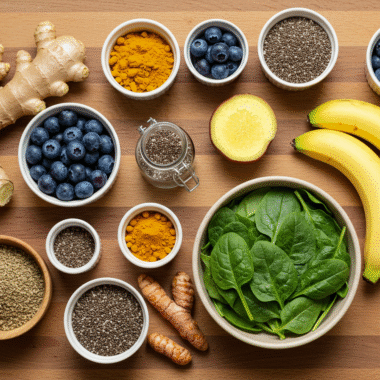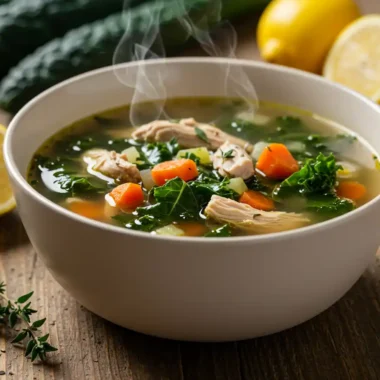When it comes to weight loss, the hardest part isn’t cooking healthy meals. It’s what happens between them. The snacking. The cravings. The “just one bite” decisions. After years of working with clients healing from inflammation, sugar crashes, and stubborn belly fat, I’ve found one simple pantry staple that changes the game—freeze dried fruit for weight loss.
Not all fruits are created equal. Not all drying methods are either. Unlike the sticky, sugar-coated dried fruits you’ll find in most stores, freeze dried fruit is crisp, light, naturally sweet, and nutrient-dense. It satisfies sweet cravings without adding bloat, excess calories, or processed junk. More importantly, it fits beautifully into anti-inflammatory meal plans.
In this guide, I’ll break down the real science behind freeze dried fruit, how I use it in client programs, my favorite fat-burning recipes using it, and why this overlooked snack deserves a spot in every weight-conscious kitchen.
Looking for more inflammation-fighting blends?
Check out my anti-inflammatory smoothie recipes for pain, gut, and energy support
Want to explore the article content? Click here to see the table of contents!
Table of Contents
Understanding Freeze Dried Fruit for Weight Loss
What Is Freeze Dried Fruit and Why It Matters
Freeze drying is a two-step preservation process where fruit is first frozen, then placed under a vacuum so the ice turns directly into vapor—no melting, no cooking. That means more nutrients, better texture, longer shelf life, and none of the added sugars or sulfites you often find in conventional dried fruit.
Clients often ask me: “Isn’t dried fruit just dried fruit?” Not even close. With freeze drying, you’re keeping the fruit’s original fiber, antioxidants, and micronutrients—things that support metabolism and curb sugar spikes—intact. It’s the closest thing to whole fruit, minus the water.
How Freeze Dried Fruit Supports Weight Loss
Let’s talk real results. When you’re aiming to lose weight, snacks need to work with your body, not against it. Here’s how freeze dried fruit earns its place in your pantry:
- Low in Calories (when portioned right): Freeze dried strawberries, for instance, clock in at just 35–40 calories per 10g.
- High in Fiber: That natural fruit fiber keeps you full, slows digestion, and helps regulate blood sugar.
- Crisp Texture: That crunch? It satisfies like chips, without the carbs or seed oils.
- Naturally Sweet: No added syrups, no need for sweeteners. Just real fruit.
One of my clients swapped her daily 150-calorie granola bar for a 40-calorie serving of freeze dried mango and said, “It’s like eating candy without the crash.”
Why This Snack Works for Inflammation Too

Strawberry Mint Fat-Burn Smoothie
Ingredients
Equipment
Method
- Add all ingredients to a high-speed blender.
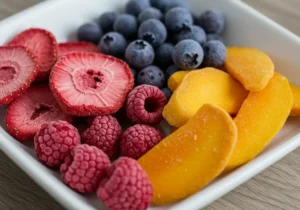
- Blend until smooth and creamy.
- Serve immediately in a chilled glass. Garnish with a mint sprig if desired.
Nutrition
Video
Notes
Weight loss is deeply tied to inflammation—especially the kind that hides in the gut, joints, and belly. Many processed snacks fuel inflammation and cravings. Freeze dried fruit, especially berries like blueberries or strawberries, contains polyphenols and antioxidants that help calm that internal fire.
As I often tell my clients, “When you reduce inflammation, your metabolism listens.”
Want to dive into other anti-inflammatory snack ideas?
Don’t miss our rhubarb recipes for healing and gut support
Nutritional Benefits of Freeze Dried Fruit
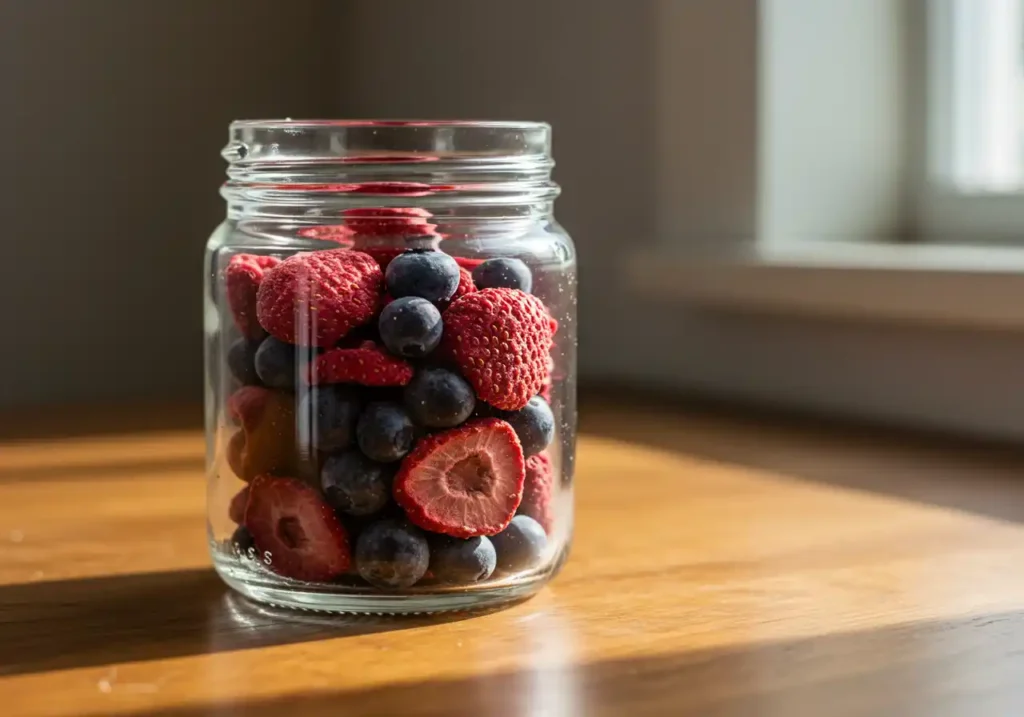
Vitamins, Fiber & Antioxidants in Every Bite
If you’ve ever looked at a slice of freeze dried peach and thought, “This can’t be healthy—it’s too tasty,” think again. Freeze dried fruit retains up to 90% of its original nutrients, including vitamin C, potassium, beta-carotene, and antioxidants that support immunity and digestion.
In my kitchen, I’ve used freeze dried strawberries to add vitamin C to smoothies, and blueberries to boost anti-inflammatory power in snack bars. One tablespoon of freeze dried raspberries has more antioxidants than a full cup of some fresh fruits.
Here’s a quick comparison:
| Nutrient | Fresh Blueberries (1 cup) | Freeze Dried Blueberries (10g) |
|---|---|---|
| Calories | 80 | 35 |
| Fiber | 3.6g | 2g |
| Vitamin C | 14mg | 9mg |
| Sugar | 15g | 6g |
It’s not just what you get—it’s what you don’t lose. That’s the real power of freeze drying.
Calorie Density vs. Nutrient Density Explained
Weight loss often fails because we chase low-calorie options without thinking about nutrient density. That’s the wrong metric. What you want is more nutrition per calorie.
Freeze dried fruits deliver that. They’re concentrated in nutrients but still low in volume and calories when portioned correctly. I often recommend a 10g serving to my clients—about a handful—which gives a satisfying crunch without the bloat or sugar spike.
The secret here is balance: You’re eating food that feeds your cells, not just fills your stomach.
Sugar Concerns & Portion Control
Let’s address the elephant in the room—fruit sugar. Yes, freeze dried fruit has natural sugar. But here’s the difference: it’s balanced by fiber, antioxidants, and water-soluble nutrients, especially when compared to dried fruit or juices.
What I tell clients is simple: “Don’t fear the sugar in a strawberry. Fear the sugar in your flavored yogurt.”
That said, portion control matters. Here’s how I help clients stay in control:
- Stick to single servings: 10–15g of freeze dried fruit is plenty for a snack.
- Pair with protein or fat: Sprinkle them over Greek yogurt or mix into chia pudding.
- Avoid sweetened versions: Always check the label. If you see cane sugar, maltodextrin, or syrup—put it back.
Want to explore a recipe that uses freeze dried fruit the right way?
Discover great ideas like our natural Zepbound weight loss recipe with citrus & fiber
Best Freeze Dried Fruits for Weight Loss
Top 5 Low-Calorie Freeze Dried Fruits to Stock
Not all freeze dried fruits are created equal when it comes to weight loss. Some pack more sugar than others, even in their natural form. After years of helping clients simplify their snacking, I’ve narrowed it down to five freeze dried fruits that I confidently recommend for fat-burning, anti-inflammatory goals.
1. Strawberries
Sweet, tart, and full of vitamin C. With only about 35 calories per 10g, freeze dried strawberries are one of the most weight-loss-friendly fruits you can buy. They blend beautifully into smoothies, yogurt, and energy bites.
2. Blueberries
These are antioxidant powerhouses. Rich in anthocyanins (which help reduce fat storage and inflammation), they offer brain and metabolic benefits. Keep your servings tight, though—they’re small but dense.
3. Apples (unsweetened)
Light, crunchy, and full of soluble fiber. I recommend freeze dried apples to clients who crave chips. Just make sure the label reads “no added sugar.”
4. Raspberries
Low sugar, high fiber, and packed with gut-friendly compounds. Freeze dried raspberries crumble easily and are great sprinkled over a protein smoothie bowl.
5. Mango (portion controlled)
This one’s a treat. Slightly higher in sugar, but if you’re active or post-workout, a 10g portion gives you energy without bloat. Choose mango when you need a mental pick-me-up without reaching for candy.
Here’s a quick chart to compare calories per 10g of each:
| Fruit | Calories | Fiber | Best Use |
|---|---|---|---|
| Strawberries | 35 | 2g | Smoothies, yogurt, desserts |
| Blueberries | 38 | 2.5g | Snack packs, energy bites |
| Apples (unsweet.) | 40 | 1.7g | On oats, in trail mix |
| Raspberries | 36 | 3g | Sprinkle over chia pudding |
| Mango | 45 | 1.2g | Post-workout smoothie |
Fruits to Limit on a Weight Loss Plan
Some fruits, while healthy in general, aren’t ideal in freeze dried form when your goal is fat loss—especially if you struggle with blood sugar control.
Here’s what I tell my clients to watch out for:
- Bananas – Too high in natural sugars once dehydrated. Use sparingly.
- Pineapple – Delicious but high-glycemic. Save it for post-exercise recovery.
- Grapes (raisins) – These spike insulin quickly and rarely come unsweetened.
- Dates – Dense in sugar and calories. A little goes a long way.
Always ask yourself this: Is this fruit freeze dried with nothing added? No oils, no sugars, no preservatives? If not—don’t buy it.
How to Read Freeze Dried Nutrition Labels
Many of the so-called “health” brands sneak in sugar, oil, or even color additives. When you’re shopping, the ingredients list should be a single word: “strawberries” or “blueberries.” Nothing else.
Here’s what I teach all my clients:
- Check for added sugar (avoid anything listing cane sugar, juice concentrate, or maltodextrin).
- Watch the serving size (some packages hide small servings).
- Look for USDA Organic or Non-GMO if possible—especially for berries.
Don’t miss our full breakdown of inflammation-friendly fruit blends
Looking for inspiration? Try these gut-calming smoothies
How to Incorporate Freeze Dried Fruit in Your Daily Meals
Breakfast Additions: Smoothies, Oats & Yogurt Toppers
The first place I teach my clients to use freeze dried fruit is breakfast—because it sets the tone for everything that comes after. And no, you don’t need a gourmet kitchen. You just need the right pantry staples and five minutes.
Smoothies: Add a tablespoon of freeze dried strawberries or blueberries to your morning blend. They amplify flavor, color, and nutrition without watering down your mix. Plus, they thicken naturally once they rehydrate.
Oats: Stir freeze dried apples or raspberries into overnight oats. They’ll soften overnight, and release their natural sweetness, eliminating the need for maple syrup.
Yogurt Bowls: Top Greek yogurt with a mix of crushed freeze dried mango and chia seeds for a protein-packed, anti-inflammatory start.
Here’s a quick prep idea my clients love:
Simple Strawberry Oat Power Bowl
- ½ cup unsweetened oats
- ¾ cup almond milk
- 1 tbsp crushed freeze dried strawberries
- 1 tsp chia seeds
- Dash of cinnamon
Soak overnight and enjoy cold or warm.
Smart Snacking for Busy Schedules
Snacking is often where diets fall apart. That’s why freeze dried fruit can be your insurance policy against poor decisions when you’re hungry and rushed.
I recommend making pre-portioned snack packs with:
- 10g freeze dried fruit
- 1 tbsp almonds or walnuts
- Optional: sprinkle of cinnamon or cacao nibs
Keep these packs in your purse, desk drawer, or glove box. You’ll always have a sweet-crunchy snack that won’t send your blood sugar crashing.
If you’re traveling or at work, pair a freeze dried fruit snack with a green tea or protein shake. Clients who used to reach for vending machine candy say this habit alone helped them lose 5–10 pounds over a few months—without any calorie counting.
Using Them in Savory Meals (Yes, Really!)
This surprises a lot of people—but I often use freeze dried fruit to brighten savory dishes. The sweet acidity of strawberries or mango pairs beautifully with earthy ingredients like quinoa, lentils, or leafy greens.
Try this Chef-approved combo:
Crunchy Quinoa Citrus Salad
- 1 cup cooked quinoa
- 1 tbsp freeze dried mango, crushed
- 1 tbsp olive oil
- Handful of arugula or baby kale
- Squeeze of lemon
- Salt + black pepper to taste
This dish supports digestion, gives long-lasting energy, and tastes like something from a boutique café—but you made it in ten minutes flat.
You can also add freeze dried blueberries to a balsamic reduction over grilled chicken or turkey. I call it “functional flavor”—because taste and fat-burning don’t have to live on opposite sides of your plate.
Don’t miss our high-fiber anti-inflammatory food tips
Check out our rhubarb recipe collection for natural healing meals
Chef Sarah’s Freeze Dried Fruit Weight Loss Recipes
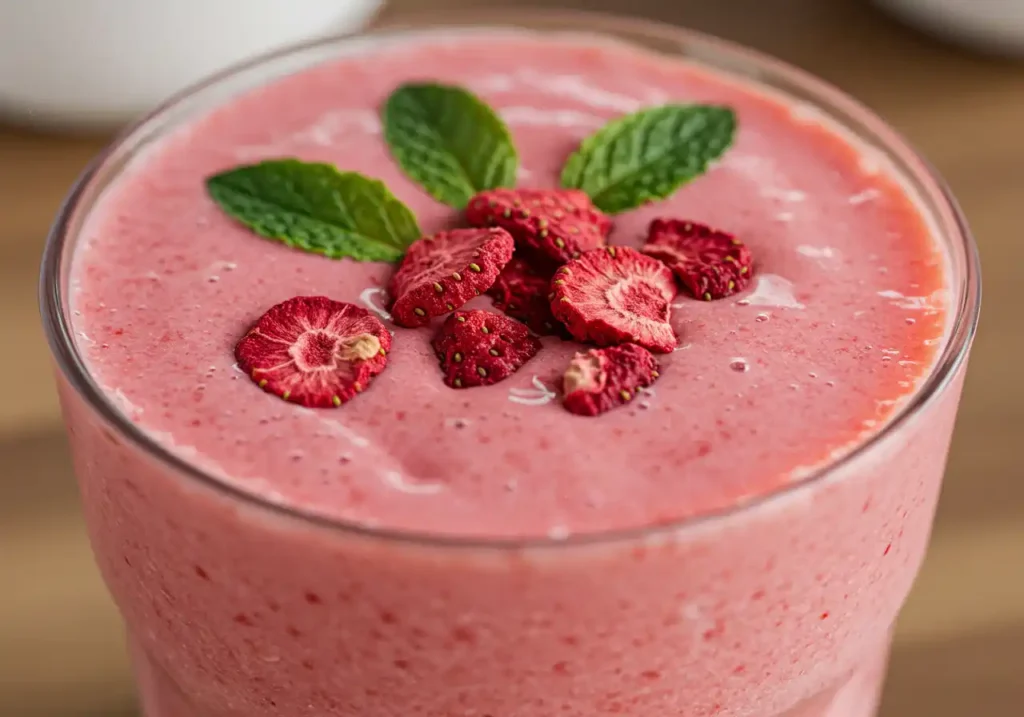
You don’t need fancy powders, pills, or sugar-packed bars to see results. When clients ask me for something sweet, satisfying, and metabolism-friendly, I point them to my freezer, my blender, and one ingredient that always delivers—freeze dried fruit.
Below are three recipes I’ve used with clients healing from inflammation, struggling with sugar cravings, and looking to stay consistent on a fat-loss plan without sacrificing joy or flavor.
Recipe #1: Strawberry Mint Fat-Burn Smoothie
This smoothie is cooling, fat-burning, and bloat-reducing—especially first thing in the morning or post-workout.
Ingredients:
- 1 cup cold unsweetened almond milk
- ½ frozen banana
- 1 tbsp freeze dried strawberries
- ¼ avocado
- 4 fresh mint leaves
- ½ tsp grated ginger
- Juice of ½ lemon
- 1 tbsp chia seeds
- Optional: 1 scoop unflavored plant protein
Instructions:
Blend all ingredients until smooth. The strawberries rehydrate in the mix, offering natural sweetness and antioxidants. The mint and lemon brighten the flavor while ginger activates digestion.
Chef’s Note: I recommend this smoothie for clients with sluggish metabolism or morning water retention. It’s gentle on the gut and deeply hydrating.
Recipe #2: Crunchy Apple-Cinnamon Energy Bowl
This bowl is designed for mid-morning or post-lunch slumps—when sugar cravings sneak in. It fuels without the crash.
Ingredients:
- ¾ cup unsweetened Greek yogurt or coconut yogurt
- 1 tbsp crushed freeze dried apples
- ½ tsp Ceylon cinnamon
- 1 tbsp ground flaxseed
- 1 tsp pumpkin seeds
- Optional: ½ tsp raw honey (if needed)
Instructions:
Mix all ingredients in a bowl and let sit for 5 minutes so the apples soften slightly. The fiber-protein-fat balance makes it an excellent choice for appetite control and gut health.
Chef’s Note: Clients with blood sugar issues see huge benefits from this bowl when used as a snack replacement.
Recipe #3: Tropical Citrus Infusion Water
Not all weight loss recipes have to be meals. Sometimes, hydration is the key—and this recipe delivers flavor, antioxidants, and zero calories.
Ingredients:
- 24 oz filtered water
- 1 tbsp freeze dried mango
- 1 tsp freeze dried pineapple
- 2 slices fresh orange
- 3 slices cucumber
- Ice
Instructions:
Add all ingredients to a large jar and let infuse for 30–60 minutes in the fridge. The fruit rehydrates slowly, flavoring the water without added sugars or juices.
Chef’s Note: This is my go-to for clients who “forget to hydrate.” It supports lymph flow and helps reduce bloat naturally.
Want more functional hydration ideas?
Learn more about our natural Zepbound-inspired weight loss drinks
Freeze Dried Fruit vs Other Fruit Forms
Freeze Dried vs Dried Fruit: Which Is Better?
This is a question I get all the time in my kitchen workshops. The short answer? Freeze dried wins—every time—if weight loss and inflammation reduction are your goals.
Let’s break it down:
| Feature | Freeze Dried Fruit | Conventional Dried Fruit |
|---|---|---|
| Preservation | Freeze without heat | Heated and dehydrated |
| Nutrients | Retains up to 90% | Loses 30–50% |
| Added Sugar | Often none | Frequently sweetened |
| Texture | Light & crisp | Sticky & chewy |
| Shelf Life | Long, no preservatives | Shorter, may need additives |
With freeze dried fruit, you’re keeping most of the fiber, antioxidants, and structure—without the spike in sugar that comes from heat-damaged sugars in dried fruit.
Clients who switch from raisins or dried cranberries to freeze dried berries often notice less bloating, fewer cravings, and better portion control within a week.
Fresh vs Frozen vs Freeze Dried: Pros and Cons
I believe in using whatever form of fruit makes healthy eating more consistent. That said, each option has its pros and cons—especially when you’re working toward fat loss and digestive health.
Fresh Fruit
- Pro: Hydrating, raw enzymes intact
- Con: Spoils quickly, not travel-friendly
Frozen Fruit
- Pro: Budget-friendly, great for smoothies
- Con: Needs freezer storage, not portable
Freeze Dried Fruit
- Pro: Portable, long shelf life, zero prep
- Con: Can be overconsumed if not portioned right
For my busiest clients—the ones juggling work, kids, and real life—freeze dried is the most sustainable. It doesn’t require refrigeration, it’s easy to measure, and it’s a no-excuses snack that still supports gut health and fat-burning goals.
Which Is Best for Your Goals?
Here’s how I guide clients based on lifestyle:
- Want daily smoothies? Use frozen.
- Need something for travel or work snacks? Use freeze dried.
- Have time for prep and sit-down meals? Mix in fresh.
- Craving something crunchy that won’t trigger a binge? Freeze dried is your tool.
The key isn’t perfection. It’s having the right tool in the right moment. Freeze dried fruit makes clean eating easier in those moments when discipline alone won’t cut it.
Common Mistakes to Avoid
Overeating Freeze Dried Fruit
Just because it’s fruit doesn’t mean more is better.
One of the first things I teach new clients is how concentration works in freeze drying. Ten grams of freeze dried strawberries might be equal to a whole cup of fresh. That’s powerful, but it also means calories and sugars can sneak in fast if you’re munching straight from the bag.
Mistake: Eating half the bag while working on your laptop.
Fix: Pre-portion your servings—10 to 15 grams max—into jars or bags for the week. Pair with a protein or fat (like almonds or yogurt) for blood sugar balance.
Remember, this isn’t about restriction. It’s about awareness. Freeze dried fruit is a tool—not a free-for-all.
Buying Sweetened or Additive-Packed Brands
This one frustrates me as a chef. So many “healthy” brands load their freeze dried fruit with cane sugar, syrup, fruit juice concentrate, or sunflower oil. Some even dust their fruit with flavoring powders.
Clean freeze dried fruit should have one ingredient. Just one.
If the ingredient list says “strawberries,” you’re good. If it says “strawberries, sugar, sunflower oil,” put it back.
Look out for:
- Sulfites (used to preserve color)
- Maltodextrin (a hidden sugar)
- Natural flavorings (can trigger cravings)
Your body deserves real food, not processed imitations.
Misunderstanding Serving Sizes
Another common trap is thinking a handful equals a serving. In reality, a true serving of freeze dried fruit is around 10–15 grams, depending on the fruit.
Use a kitchen scale until you know what that looks like. For example:
- 1 tbsp freeze dried blueberries = ~6g
- 1/4 cup freeze dried strawberries = ~10g
- 2 slices freeze dried mango = ~8g
This is especially important for clients on low-carb, low-sugar, or inflammation-specific plans. Even natural sugars can cause fatigue, cravings, or weight plateaus when overdone.
Pro tip: Use freeze dried fruit as a booster—not a base. Think of it like a topping, not the entire snack.
Freeze Dried Fruit & Inflammation
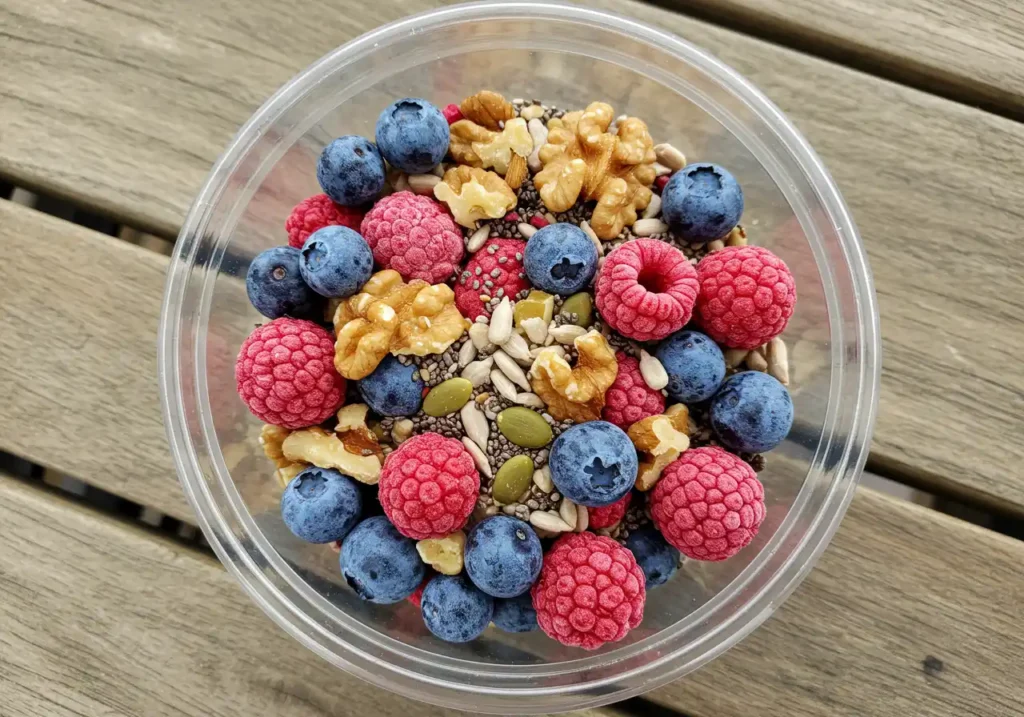
How Certain Fruits Can Calm Inflammation
If there’s one thing I see in nearly every client struggling with weight—it’s hidden inflammation. It’s not just about calories in vs. calories out. It’s about what your body is reacting to.
The good news? Certain freeze dried fruits offer not just flavor—but real anti-inflammatory compounds. Here’s what I reach for in my kitchen:
- Freeze Dried Blueberries: Rich in anthocyanins, they help lower oxidative stress markers and protect the gut lining.
- Freeze Dried Raspberries: High in ellagic acid, which supports detox pathways and reduces cellular inflammation.
- Freeze Dried Strawberries: Packed with vitamin C and polyphenols that reduce skin, joint, and immune-related inflammation.
I’ve had clients with joint pain and digestive distress see real relief after incorporating these regularly—as part of smoothies, chia puddings, and even hydration infusions.
Best Freeze Dried Choices for Gut Health
When it comes to gut inflammation, fiber is essential. But not just any fiber. You want gentle, fermentable fibers—and certain freeze dried fruits are ideal sources.
Top picks for gut support:
- Freeze dried apple (unsweetened): Rich in soluble pectin, great for calming the GI tract.
- Freeze dried bananas (in moderation): Contain prebiotic resistant starch when slightly green.
- Freeze dried mango: Offers enzymes that support digestion, especially after meals.
I often recommend these fruits be added into blended yogurt, kefir bowls, or overnight oats, where they rehydrate and deliver more than just sweetness.
Try this gut-friendly combo:
- ¾ cup kefir (plain, unsweetened)
- 1 tbsp freeze dried apple pieces
- ½ tbsp flax meal
- 1 tsp raw honey
- Dash of cinnamon
Mix, let sit 10 minutes, and enjoy a digestion-soothing, inflammation-calming treat.
Anti-Inflammatory Snack Strategies
To reduce inflammation with snacking, here’s what I teach:
- Pair freeze dried fruit with healthy fat (like walnuts or coconut) to slow sugar absorption.
- Use herbs and spices alongside: Cinnamon, ginger, and turmeric enhance anti-inflammatory impact.
- Rotate your fruit sources: Variety reduces food sensitivities and boosts nutrient coverage.
Here’s a quick go-to snack I use in my programs:
Berry Spice Trail Mix
- 1 tbsp freeze dried blueberries
- 1 tbsp raw walnuts
- 1 tsp pumpkin seeds
- Dash of Ceylon cinnamon
- Pinch of sea salt
Toss and store in small jars. It’s anti-inflammatory, blood sugar balanced, and travel-ready.
Want to explore more anti-inflammatory recipes?
Check out our smoothie guide for healing gut blends
Tips from Chef Sarah – Making It a Sustainable Habit
How to Shop Smart and Store Right
Freeze dried fruit doesn’t require refrigeration, but it does need smart storage to maintain freshness and crunch.
Here’s how I guide clients through the buying process:
- Always check the ingredient list: It should only list the fruit—nothing else.
- Buy in resealable, airtight pouches or transfer to glass jars with tight lids to keep out humidity.
- Look for organic or non-GMO if available, especially for berries.
Chef’s tip: For long-term freshness, store pouches in a dark cabinet away from heat. Light and moisture are the enemies of crispness.
Here’s what I keep stocked at all times:
| Fruit | Shelf Life (Properly Stored) | Best Use |
|---|---|---|
| Strawberries | 12 months | Smoothies, yogurt bowls |
| Apples (unsweet.) | 9–10 months | Oats, trail mix |
| Blueberries | 10–12 months | Energy bites, hydration |
| Mango | 6–8 months | Post-workout snacks |
Keeping Variety to Avoid Snack Burnout
Even healthy snacks can get boring if you eat them the same way every day.
Here’s how I help clients rotate variety without sacrificing progress:
- Week 1: Freeze dried fruit + nuts
- Week 2: Freeze dried in smoothies
- Week 3: Yogurt bowls + fruit toppers
- Week 4: Energy bites or water infusions
By rotating formats—not just fruits—you keep your cravings satisfied and your metabolism guessing.
Need a full routine?
Check out our 7-day anti-inflammatory smoothie plan
Meal Prep & Portion Prep for Success
Meal prep isn’t just about dinners. It’s about snack insurance—having the right foods ready when hunger hits.
Here’s a typical prep plan I give to new clients:
Weekly Freeze Dried Snack Box
- 4 mini mason jars (10g fruit + 1 tbsp seeds or nuts)
- 2 smoothie freezer packs (with freeze dried fruit + spinach + ginger)
- 2 yogurt toppers (apple chips + flax + cinnamon in baggies)
This takes less than 20 minutes and can save you from dozens of poor choices throughout the week.
Remember: Consistency—not perfection—is what burns fat and builds habits. Freeze dried fruit gives you just enough sweetness, crunch, and satisfaction to stay on track, even on your busiest days.
What’s the best dried fruit to eat for weight loss?
If we’re talking true weight loss support, freeze dried strawberries or blueberries come out on top. They’re low in calories, rich in antioxidants, and naturally sweet—without the sticky sugar spike of conventional dried fruits. I recommend a 10-gram portion for a satisfying crunch that helps reduce cravings and supports fat metabolism.
Which fruit is the best for weight loss?
It depends on your body’s needs, but generally, berries—especially blueberries, raspberries, and strawberries—are your most powerful allies. They’re low in sugar, high in fiber, and contain compounds that calm inflammation and improve insulin sensitivity. I use freeze dried berries daily in client plans for both gut health and fat-burning.
Is frozen fruit OK for weight loss?
Yes—frozen fruit is excellent for weight loss, especially when used in smoothies. Just avoid fruit blends with added sugar or syrups. In my programs, I often combine frozen fruit with freeze dried options for texture, flavor, and variety. Both forms are valuable tools when used intentionally.
Are freeze-dried fruits high in calories?
Not when portioned correctly. Most freeze dried fruits contain 30–45 calories per 10g serving. The trick is being mindful—since the water is removed, it’s easy to over-snack. That’s why I always teach clients to measure servings and pair with fiber or protein for balance. Used right, freeze dried fruit is one of the lowest-calorie snacks with the highest nutrient return.
Want more healthy recipes and fat-burning meal ideas? Follow me on Pinterest at Sarah Weight Loss Ideas
